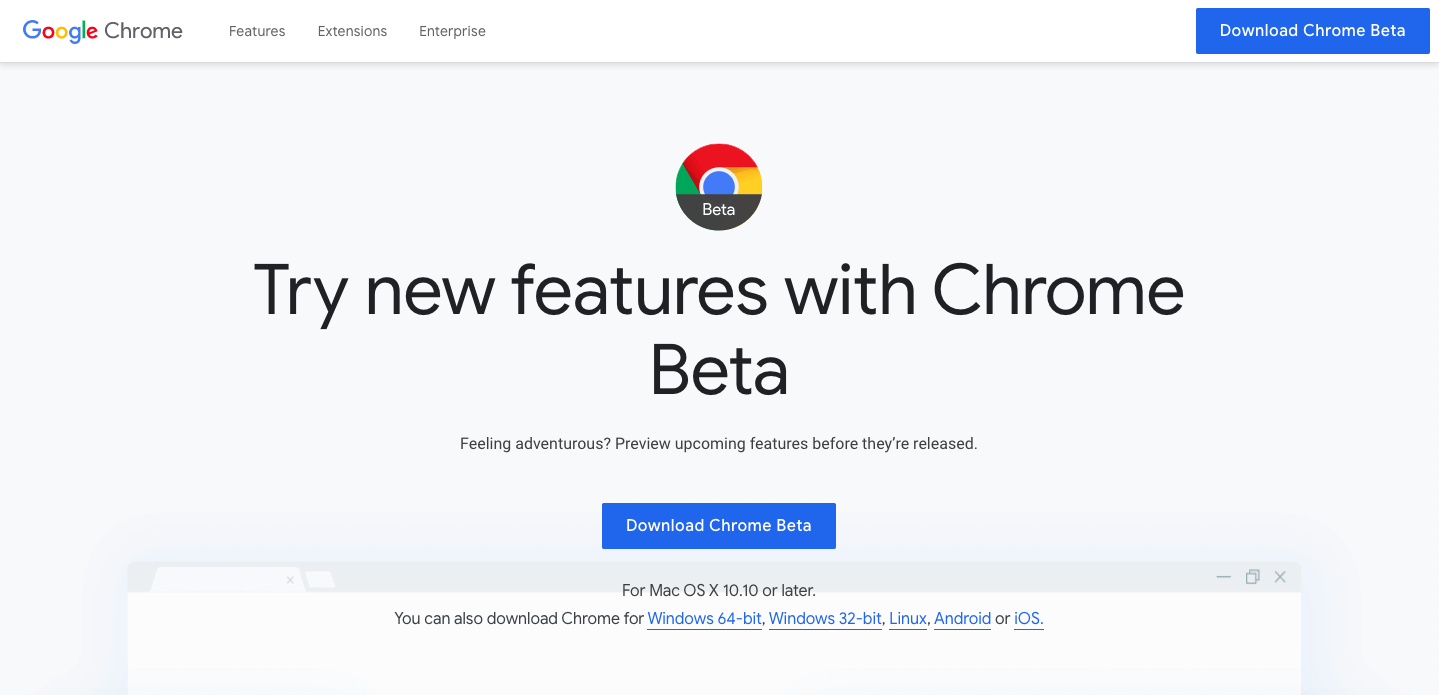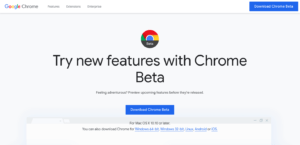How to Get Access to Chrome Beta

Google Chrome comes in four release channels: Stable, Beta, Dev, and Canary.
- Stable is the channel that’s publicly released, you’re probably using it right now.
- Beta is the next upcoming version that’s in final testing before it’s released to the Stable channel.
You can get access to all four channels for free. While there are some downsides to using the Beta channel, there are also some compelling reasons to download it.
This post covers everything you should know. First, how do you get the current Beta version of Chrome?
How to install Chrome Beta
For Mac OSX, Windows 32 and 64, and Linux:
Go to the Chrome Beta homepage and click Download Chrome Beta.

The website will automatically detect your operating system and offer you the download that matches your OS. The desktop version is available for Mac OSX, Windows 32- and 64-bit, and Linux.
After you click Accept and Install, you’ll get a download. Open and install from your computer as usual, and then close and re-open Chrome.
For iOS:
First, install Testflight, which lets developers test applications on mobile devices.
Next, tap the link on your iPhone or iPad after you install Testflight, and restart Chrome once installation is complete.
For Android:
Go straight to the Play Store and install Chrome Beta from there. Then restart Chrome.
For Chromebook:
Chromebooks don’t work the same way that traditional desktops or mobile devices do. To get Chrome Beta on your Chromebook, you’ll need to be the owner. If an organization administers your Chromebook, you likely won’t be able to change channels.
Also keep in mind that changing channels to Beta on Chromebook will shift the whole Chromebook over to Beta. When you shift back to Stable, you will lose everything from your Chromebook. Cloud storage on Drive won’t be affected, but everything saved locally will be erased.
If you still want to change channels on your Chromebook, here’s how:
- Sign in to your Chromebook with the owner’s account, and go to the menu by clicking the time.
- Select Settings > About Chrome OS > Detailed Build Information > Channel.
- Next to Chanel, choose Channel Change and select Beta. Your Chromebook will download and install the update, then prompt you to restart.
To check your installation has worked, open the Chrome menu and go to Help > About Google Chrome to see the version number. Beta is usually a couple of version numbers ahead of Stable Chrome: at the time of writing, desktop Beta was 79.0.3945.36 for desktops and laptops, and 79.0.3945.36 for iOS and Android, with the mobile build released later the same day.
To check the current numbers, go here.
Why should you install Chrome Beta?
There are several reasons to choose Chrome Beta. It’s a less stable but more advanced version than the one on general release.
While it’s not a totally reliable representation of what’s coming up, Chrome Beta is used as a clearinghouse for features that will become part of Stable Chrome. Beta users get to see Chrome’s upcoming features. While not all of them will go live, many of them do.
For some, the extra functionality of Beta is a requirement for their job. Others might just like to have a more up-to-date, feature-rich Chrome experience that’s updated more regularly.
Here are a few examples of use cases:
IT departments: QA testing
IT departments need to know in advance if new versions of Chrome are going to cause glitches with the tools they use. Software companies need to QA test their products, and Chrome Beta is a constant part of that process, which is often semi-automated through Chromedriver.
Developers: Integrations with Chrome
For developers creating apps or websites, Chrome integrations are crucial. Knowing how your site will appear and function in the most widely-used browser is vital, and Beta lets developers match their creations to the latest build before everyone else is using it so they can troubleshoot in advance. Beta also often has additional functionalities for developers that are introduced in later stable builds, including third-party tools like flags that aren’t available in Stable.
Personal users: New features
In addition to developer-friendly functions inside Dev Tools, Chrome trials new features for users in Beta. This means an opportunity to road-test the newest Chrome functionality before it becomes mainstream, which is attractive to Chrome power users.
What is the difference between Chrome Beta and Chrome Canary?
Chrome Beta is advanced and close to release. Canary is purely experimental. Beta gives you a snapshot of what Chrome will be unless major issues arise. In Canary, major issues are expected. It’s unstable, prone to crashing and glitching, and while it comes with a ton of useful features, it’s unreliable by nature.
Chrome Beta is mostly stable. You might get the odd bug that wouldn’t have made it through to Stable, but it’s far from the “bleeding edge” promised by Canary. It’s updated every week and gets a major update every six weeks, whereas Canary is updated nightly. Even developers won’t run Canary as their main Chrome install, which is why it’s the only Chrome channel that runs alongside regular Chrome. Beta and Dev replace it.
How to uninstall Chrome Beta
To revert to Stable from Beta, you’ll need to uninstall Chrome, then reinstall Stable. Here’s how to uninstall Chrome on your device.
For Mac OSX:
Quit Chrome and go to Applications in Finder. Find Chrome and drag it to the trash.
You should also delete browsing history, bookmarks, and profile information from your computer so that Stable installs without a hitch. To do that, go to File > Find > Go to folder and enter: ~/Library/Application Support/Google/Chrome
Select all the files from that folder and drag them to the trash.
To reinstall Chrome, download the installation file here. Open the googlechrome.dmg file and drag Chrome to Applications in the installation window.
For Windows 10:
Quit Chrome and go to Start > Settings. Click Apps > Apps and features, and find and select Google Chrome. Click Uninstall and confirm by clicking Uninstall when prompted.
To delete profile information, browsing history, and bookmarks, check the box marked “Also delete your browsing data.”
To reinstall, download the installation file here. Chrome will open automatically after it’s finished downloading and installing.
For Windows Vista, 7, and 8:
Quit Chrome and go to the Control Panel. This is in the Start menu > Control Panel in Windows Vista and 7. In Windows 8 it’s in Settings > Control Panel. Click Uninstall a Program or Programs and Features, and double-click Google Chrome.
To delete your profile information, bookmarks, and history so that Stable installs without a hitch, check the box marked “Also delete your browsing data.”
To reinstall Chrome, download the installation file here. If you’re prompted, click Run or Save, and if you clicked Save, double-click the download after it’s completed to start installation.
For Linux:
Open a terminal window. In GNOME, Unity, and Cinnamon, press CTRL+ALT+T. In KDE environments, select Application Menu > System > Console.
If you have a Debian-based system, enter: sudo dpkg -r google-chrome-stable
If you have a non-Debian system, enter: sudo rpm -e google-chrome-stable
Enter your computer’s password when prompted.
To reinstall Chrome, download the installation file here. Click OK to open the package, then click Install package.
For iOS:
Tap and hold the Chrome app on your device, and at the top left of the icon, tap Remove. Tap delete when prompted to delete Chrome and associated browsing information and profile data.
To reinstall Chrome go to Chrome on the App Store. Tap Get, then Install, enter your Apple ID password, and tap OK.
For Android:
Removing Chrome from Android devices isn’t usually an option: the majority come with the browser built-in. What you can do is reset it to an earlier version.
To do that, go to Settings > Applications > Application Manager > Uninstall Updates. OK that when prompted and your Android devices’ version of Chrome will be reset to the version it came with. Then, when you open Chrome, you’ll be prompted to update to the latest stable build.
For Chromebook:
When you revert Chrome to Stable on a Chromebook, you have to wipe the machine, since Chrome is the OS as well as the browser.
Sign in to your Chromebook with the owner account and click the time in the bottom right corner of the screen. Then click Settings > About Chrome OS > Detailed Build Information > Channel.
Select Change Channel, and click Change Channel and Powerwash. After the update installs, click Relaunch and Powerwash. Your Chromebook will powerwash, erasing all locally stored data.
Should you avoid installing Chrome Beta?
If you are a developer or engineer, Chrome Beta offers a huge advantage. If you aren’t a development, IT, or software professional, there’s no real reason to use it.
Most users simply don’t need the advanced features faster than the public release. You get all the extra bugs but without any upside.
The only other reason to use Beta is if you just like to use the latest, most advanced tools. In which case, have at it.

